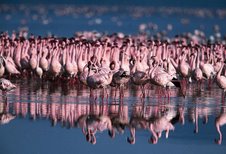The history of Tanzania is filled with stories of struggle and
triumph, victory and peace. This rich history can be traced as far as;
from the beginning of human settlement and Tribal Habitation to the
beginnings of trade and merchant states along the Swahili Coast. Rich
traces also include the arrival of colonialism and the advent of
independence while political details and the modern Tanzania are not to
be ignored.
Tanzania has a long history of human habitation – some of the
earliest hominoid fossils in the world were discovered in Olduvai Gorge
and show records of hominoid habitation in the region going back at
least 3 million years. It is thought that early hunter-gatherer
communities inhabited the northern highlands as far back as 10,000 years
ago and remained largely isolated until the arrival of
Cushitic-speaking tribes from the north, who brought basic agricultural
technologies to the area between 3,000 and 5,000 years ago.
More recent migrations of Bantu-speaking tribes from western Africa
began around 1000 BC, and with their assimilation came advances in iron
and steel production. Ancestors of the Maasai arrived more recently,
beginning their migration around the 15th century and continuing to
arrive from the area around southern Sudan for another three hundred
years. Battles over grazing and agricultural land began as ethnic groups
consolidated and appropriated loose borders and tribal regions.
Trade routes that led from the heart of the continent to the East
African coast gradually gave rise to Swahili culture – a blend of Arab,
Indian and Bantu influences that created one of the most developed trade
networks in the Indian Ocean.
Although archaeological evidence shows the area was used as a trading
port for Greek and Persian ships as early as 400 BC, permanent coastal
settlements only developed around 800 AD, when civilizations around the
Indian Ocean were wealthy enough to support annual voyages and a high
volume of trade.
With large caravans laden with gold, spices, ivory, and slaves
departing from Zanzibar, Kilwa, and other less prominent East African
ports, Swahili civilization grew and flourished until the 15th century,
when trade became more confined to Mombasa and Zanzibar.
Portuguese traders dominated the East African coast from 1525 until
the early 18th century, when Omani Arabs once again regained control of
the slave trade. The first missionaries journeyed to the mainland in the
early 19th century and settlements, mission stations, and trading posts
were built as far inland as Lake Tanganyika.
In the late 19th century, the German East African Company gained
control of large portions of the Tanzanian mainland, although the
British held a sphere of influence over the Omani sultans ruling the
Zanzibar Archipelago. By 1891, most of mainland Tanzania was under the
colonial administration of German East Africa.
At the end of World War I, the Germans relinquished control over the
area and handed it over to British administration that governed by a
system of indirect rule.
A fledgling national movement in opposition to colonial economic
policies was founded in the 1930’s and by the early 1950’s; the movement
came into its own. In 1954, an internal constitution was drawn up and
resistance unified under the Tanganyika African National Union (TANU)
with Julius Nyerere elected as its president.
After further elections in 1959, Britain established an internal
self-government within the country and by 1962 the independent Republic
of Tanganyika was formed with Nyerere as president.
Meanwhile, a popular revolution on the island of Zanzibar ousted the
Omani sultan and in 1963, the archipelago gained its independence from
British influence and Arab rule. One year later, leaders Nyerere and
Karume, the first president of Zanzibar, signed an act of union to
create the United Republic of Tanzania, which includes the Republic of
Tanganyika and the Revolutionary Government of Zanzibar.
Today, Tanzania is a sovereign state under the ruler- ship of His Excellency president Jakaya Kikwete
PKP. safaris in kenya desk.
Natural Track Safaris
Thursday, November 15, 2012
Monday, November 12, 2012
Hiking the Ruwenzori – Superb reward, magnificent scenery
The
enchanted Ruwenzori mountain ranges lie in the Western Uganda along the
Congolese boarder with a height of 5,100m above sea level. These unique snow -
covered equatorial peaks of Ruwenzori rank among the highest ranges in Africa.
Its lower slopes are mantled in moorland and rich mountain forest covering
about 100 km in length and about 50 km in width.
Ruwenzori
Mountains National Park protects the eastern slopes and glacial peaks of the
120km-long Ruwenzori Mountains a world-class hiking and mountaineering
destination. Most of the park is accessible only to hikers although the magnificent
scenery and 19 Albertine Rift endemics would be ample reward for Birders.
The Ruwenzori’s are referred to as the ‘Mountains of the
Moon’ simply because the Roman Geographer Ptolemy Circa (AD 150) believed them
to be the Lunae Montes predicted by
the ancient Greeks to be the source of The Nile River.
The mountain peaks thereof have been named after early
explorers to Uganda. Some of those in the centre of the range have snow cover.
These include Mount Stanley (5,110m), Speke (4,889m), Baker (4,843m), Gessi
(4,797m), Emin (4,791m) and Luigi di Savoia (4,626m). On Mt. Stanley are the
twin summits of Alexandra (5,044m) and Margherita (5,110m).
These beautiful, often mist-shrouded mountains are
non-volcanic and offer mountaineers and walkers splendid country and wonderful
views. With their geographical nature,
the Ruwenzori’s’ can boast of their challenging hiking and climbing
possibilities notwithstanding the diverse flora and fauna on different altitude
zone each with its own micro-climate.
The real adventure commence from Entebbe International
Airport or the Uganda’s capital Kampala, from whence you will head to Western
Uganda. After a night of acclimatization, you are now ready to boldly rough the
Ruwenzori.
Its now the second day of the hike, when you advance to Nyakalengija (1,615m) – the beautiful trail meander off Fort Portal road as you strive to access Nyabitaba Hut (2,651m) through thick tropical vegetation.
Its now the second day of the hike, when you advance to Nyakalengija (1,615m) – the beautiful trail meander off Fort Portal road as you strive to access Nyabitaba Hut (2,651m) through thick tropical vegetation.
Nyakalengija is 10 km before Nyabitaba Hut, passing first
through cultivation then through forest arriving Nyabitaba Hut in the evening. If
you have your own or rental car, don’t worry! There is a campsite and safe
parking near the Nyahalengija office.
The third day is usually characterized by the longest;
perhaps the most hectic stretch of the hike. After early breakfast, depending on
the two Bigo Bogs, which are often
knee-deep in mud, it may take you up to five hours before accessing the Bujuku
Hut. En route you will be able to view Lake Bujuku that has a splendid setting
between mounts Speke and Stanley Baker. Bujuku Hut will enable you to easily
access Mt. Speke and this may mean spending an extra night here.
In case you intend to climb the highest point in the range -
Margherita Peak on Mt. Stanley(5,109m) you will need to start from Elena
Hut(4,541m)- 2 km off the loop trail and about four hours’ walk from either
Bujuku or Kitandara Huts.
The fourth and fifth day entail an effortful ascend to Scott
Elliot Pass – the highest point in the loop trail, (4,372m) to access Kitandara
lakes. Overnight is mainly on Katandara Hut which is on the second lake a
journey that will take over four hours of remarkable trek.
The fifth day is typically the most interesting; early in
the morning, you will ascend a steep slope to Freshfield Pass (4,282m) and then
descend to Bujongolo Cave (3,720m). En route the trail to Kabamba
Cave(3,450m) there is a magnificent waterfall and a rock shelter where you can stay overnight as an alternative to Guy
Yeoman Hut.
Very early in the morning you will move through gorgeous scenery of Savoia and Elena glaciers as you ascend through the Scott Elliot pass and go through the snow to Elena Hut. After an early breakfast ascend the snow-covered Alexander peak (5,092m) and proceed to the Supreme peak (5,109m). Here you will be rewarded by enjoying a beautiful panoramic view of world around you, then descend to Kitandara Hut for overnight right at the shores of Lake Kitandara.
Very early in the morning you will move through gorgeous scenery of Savoia and Elena glaciers as you ascend through the Scott Elliot pass and go through the snow to Elena Hut. After an early breakfast ascend the snow-covered Alexander peak (5,092m) and proceed to the Supreme peak (5,109m). Here you will be rewarded by enjoying a beautiful panoramic view of world around you, then descend to Kitandara Hut for overnight right at the shores of Lake Kitandara.
The descend trek takes 2 to 3 days through Guy Yeoman and to
Kasese via Nyabitaba and Lake Mahoma. You may choose to stay overnight at
Nyabitaba Hut or proceed to Margarita Hotel to a comfortable rest from the long
strenuous exercise.
PKP. safaris in kenya desk
Natural Track Safaris.
Subscribe to:
Comments (Atom)








